Comprehensive Strategic Analysis of Tesco: Market Positioning Report
VerifiedAdded on 2023/06/09
|15
|3676
|102
Report
AI Summary
This report provides a detailed analysis of Tesco's business strategies, employing various strategic management tools and frameworks. It begins with a PESTLE analysis to evaluate the macro-environmental factors impacting Tesco's operations, including political, economic, social, technological, legal, and environmental elements. Subsequently, a SWOT analysis and VRIO framework are used to identify Tesco's internal strengths, weaknesses, opportunities, and threats, as well as to assess its resources and capabilities for competitive advantage. The report also applies Porter's Five Forces model to evaluate the competitive intensity within the UK supermarket sector and to determine Tesco's market positioning. Finally, it utilizes strategic planning models such as the Ansoff Matrix, Gap Analysis, and Situation Analysis to devise a strategic plan for Tesco, focusing on growth opportunities and addressing potential gaps in its current strategy. The analysis aims to provide insights into how Tesco can improve its competitiveness and sustain its market leadership.
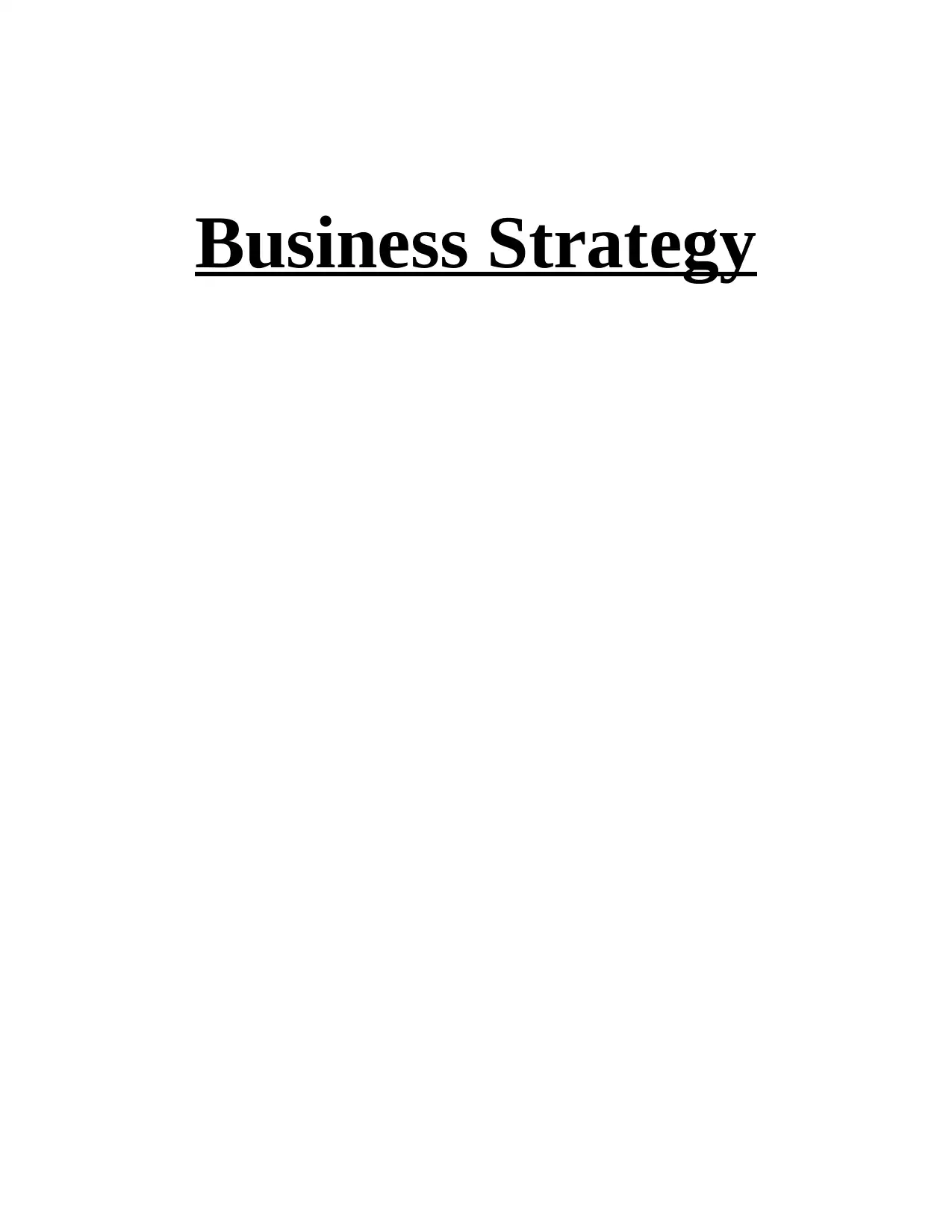
Business Strategy
Paraphrase This Document
Need a fresh take? Get an instant paraphrase of this document with our AI Paraphraser

Table of Contents
INTRODUCTION...........................................................................................................................1
TASK 1............................................................................................................................................1
P1 Macro Environment (PESTLE) Analysis of Tesco Affecting Its Strategies.....................1
TASK 2............................................................................................................................................4
P2 SWOT Analysis & VRIO Framework to Identify Capabilities of Tesco.........................4
TASK 3............................................................................................................................................7
P3 Porter’s Five Forces to Evaluate Competitive Forces and Strategies to Improve
Competitiveness and Market Positioning...............................................................................7
TASK 4............................................................................................................................................9
P4 Range of Theories, Concepts and Models (Ansoff Matrix, Gap Analysis and Situation
Analysis) to Interpret and Device Strategic plan for Tesco...................................................9
CONCLUSION..............................................................................................................................11
REFERENCES..............................................................................................................................13
INTRODUCTION...........................................................................................................................1
TASK 1............................................................................................................................................1
P1 Macro Environment (PESTLE) Analysis of Tesco Affecting Its Strategies.....................1
TASK 2............................................................................................................................................4
P2 SWOT Analysis & VRIO Framework to Identify Capabilities of Tesco.........................4
TASK 3............................................................................................................................................7
P3 Porter’s Five Forces to Evaluate Competitive Forces and Strategies to Improve
Competitiveness and Market Positioning...............................................................................7
TASK 4............................................................................................................................................9
P4 Range of Theories, Concepts and Models (Ansoff Matrix, Gap Analysis and Situation
Analysis) to Interpret and Device Strategic plan for Tesco...................................................9
CONCLUSION..............................................................................................................................11
REFERENCES..............................................................................................................................13
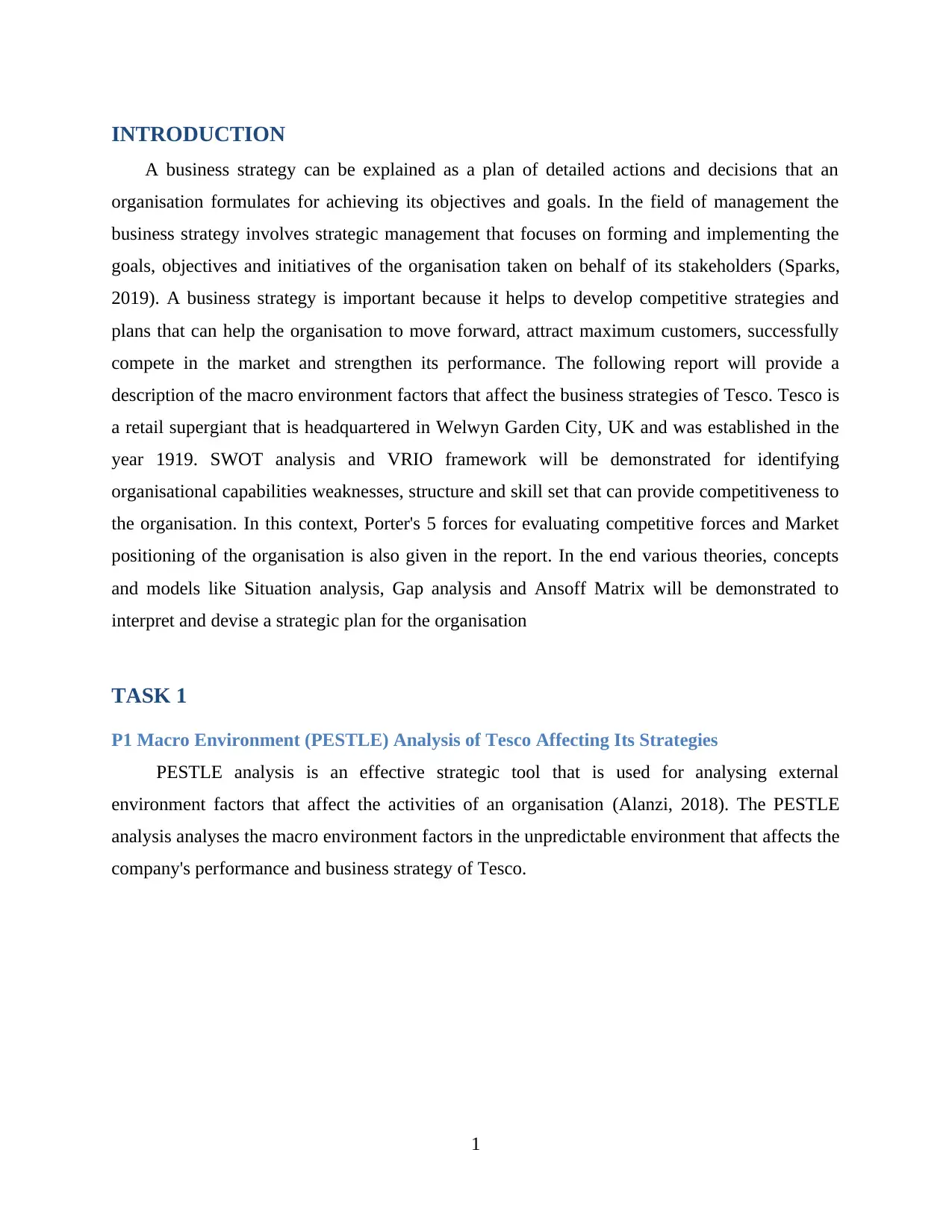
INTRODUCTION
A business strategy can be explained as a plan of detailed actions and decisions that an
organisation formulates for achieving its objectives and goals. In the field of management the
business strategy involves strategic management that focuses on forming and implementing the
goals, objectives and initiatives of the organisation taken on behalf of its stakeholders (Sparks,
2019). A business strategy is important because it helps to develop competitive strategies and
plans that can help the organisation to move forward, attract maximum customers, successfully
compete in the market and strengthen its performance. The following report will provide a
description of the macro environment factors that affect the business strategies of Tesco. Tesco is
a retail supergiant that is headquartered in Welwyn Garden City, UK and was established in the
year 1919. SWOT analysis and VRIO framework will be demonstrated for identifying
organisational capabilities weaknesses, structure and skill set that can provide competitiveness to
the organisation. In this context, Porter's 5 forces for evaluating competitive forces and Market
positioning of the organisation is also given in the report. In the end various theories, concepts
and models like Situation analysis, Gap analysis and Ansoff Matrix will be demonstrated to
interpret and devise a strategic plan for the organisation
TASK 1
P1 Macro Environment (PESTLE) Analysis of Tesco Affecting Its Strategies
PESTLE analysis is an effective strategic tool that is used for analysing external
environment factors that affect the activities of an organisation (Alanzi, 2018). The PESTLE
analysis analyses the macro environment factors in the unpredictable environment that affects the
company's performance and business strategy of Tesco.
1
A business strategy can be explained as a plan of detailed actions and decisions that an
organisation formulates for achieving its objectives and goals. In the field of management the
business strategy involves strategic management that focuses on forming and implementing the
goals, objectives and initiatives of the organisation taken on behalf of its stakeholders (Sparks,
2019). A business strategy is important because it helps to develop competitive strategies and
plans that can help the organisation to move forward, attract maximum customers, successfully
compete in the market and strengthen its performance. The following report will provide a
description of the macro environment factors that affect the business strategies of Tesco. Tesco is
a retail supergiant that is headquartered in Welwyn Garden City, UK and was established in the
year 1919. SWOT analysis and VRIO framework will be demonstrated for identifying
organisational capabilities weaknesses, structure and skill set that can provide competitiveness to
the organisation. In this context, Porter's 5 forces for evaluating competitive forces and Market
positioning of the organisation is also given in the report. In the end various theories, concepts
and models like Situation analysis, Gap analysis and Ansoff Matrix will be demonstrated to
interpret and devise a strategic plan for the organisation
TASK 1
P1 Macro Environment (PESTLE) Analysis of Tesco Affecting Its Strategies
PESTLE analysis is an effective strategic tool that is used for analysing external
environment factors that affect the activities of an organisation (Alanzi, 2018). The PESTLE
analysis analyses the macro environment factors in the unpredictable environment that affects the
company's performance and business strategy of Tesco.
1
⊘ This is a preview!⊘
Do you want full access?
Subscribe today to unlock all pages.

Trusted by 1+ million students worldwide

Figure 1: PESTLE Analysis
Source: https://business-docs.co.uk/scenario/how-do-i-do-a-pestel-analysis/
Political factors are those factors that include economic conditions like unemployment
rate, political situation, impending legislation, tax rates etc. within an economy where the
organisation operates. With headquarters in the UK, Tesco functions across many nations
globally. It is among the largest retailers in the world and it is necessary that all
mandatory regulations must be followed by the organisation for ensuring safety and
compliance of its services and products. The major political factors that affected the
organisation were during the Covid-19 crisis lockdown, Brexit and US-China trade war.
These political factors largely affect the business strategy of Tesco and the company
needs to understand the changing political conditions throughout the globe so that it can
operate effectively throughout various countries.
Economic factors are those factors related to the level of income, inflation or deflation,
cost, exchange rates etc. (HIREMATH, S., 2021). Tesco deals in a variety of products
and services and economic factors play a very important role in the consumption of a
variety of goods and services. There are many changes throughout the UK as well as
other countries that affect the delivery model of the organisation and this may incur
additional costs on the business. Tesco should focus on various economic aspects that
affect its business strategies like prices of products, income of consumers, inflation or
deflation conditions, etc. so that it can generate higher revenue. It is very important that
Tesco must be aware about taxation policies, prevailing economic conditions, cost in the
market etc. so that it can gain competitive advantage.
2
Source: https://business-docs.co.uk/scenario/how-do-i-do-a-pestel-analysis/
Political factors are those factors that include economic conditions like unemployment
rate, political situation, impending legislation, tax rates etc. within an economy where the
organisation operates. With headquarters in the UK, Tesco functions across many nations
globally. It is among the largest retailers in the world and it is necessary that all
mandatory regulations must be followed by the organisation for ensuring safety and
compliance of its services and products. The major political factors that affected the
organisation were during the Covid-19 crisis lockdown, Brexit and US-China trade war.
These political factors largely affect the business strategy of Tesco and the company
needs to understand the changing political conditions throughout the globe so that it can
operate effectively throughout various countries.
Economic factors are those factors related to the level of income, inflation or deflation,
cost, exchange rates etc. (HIREMATH, S., 2021). Tesco deals in a variety of products
and services and economic factors play a very important role in the consumption of a
variety of goods and services. There are many changes throughout the UK as well as
other countries that affect the delivery model of the organisation and this may incur
additional costs on the business. Tesco should focus on various economic aspects that
affect its business strategies like prices of products, income of consumers, inflation or
deflation conditions, etc. so that it can generate higher revenue. It is very important that
Tesco must be aware about taxation policies, prevailing economic conditions, cost in the
market etc. so that it can gain competitive advantage.
2
Paraphrase This Document
Need a fresh take? Get an instant paraphrase of this document with our AI Paraphraser
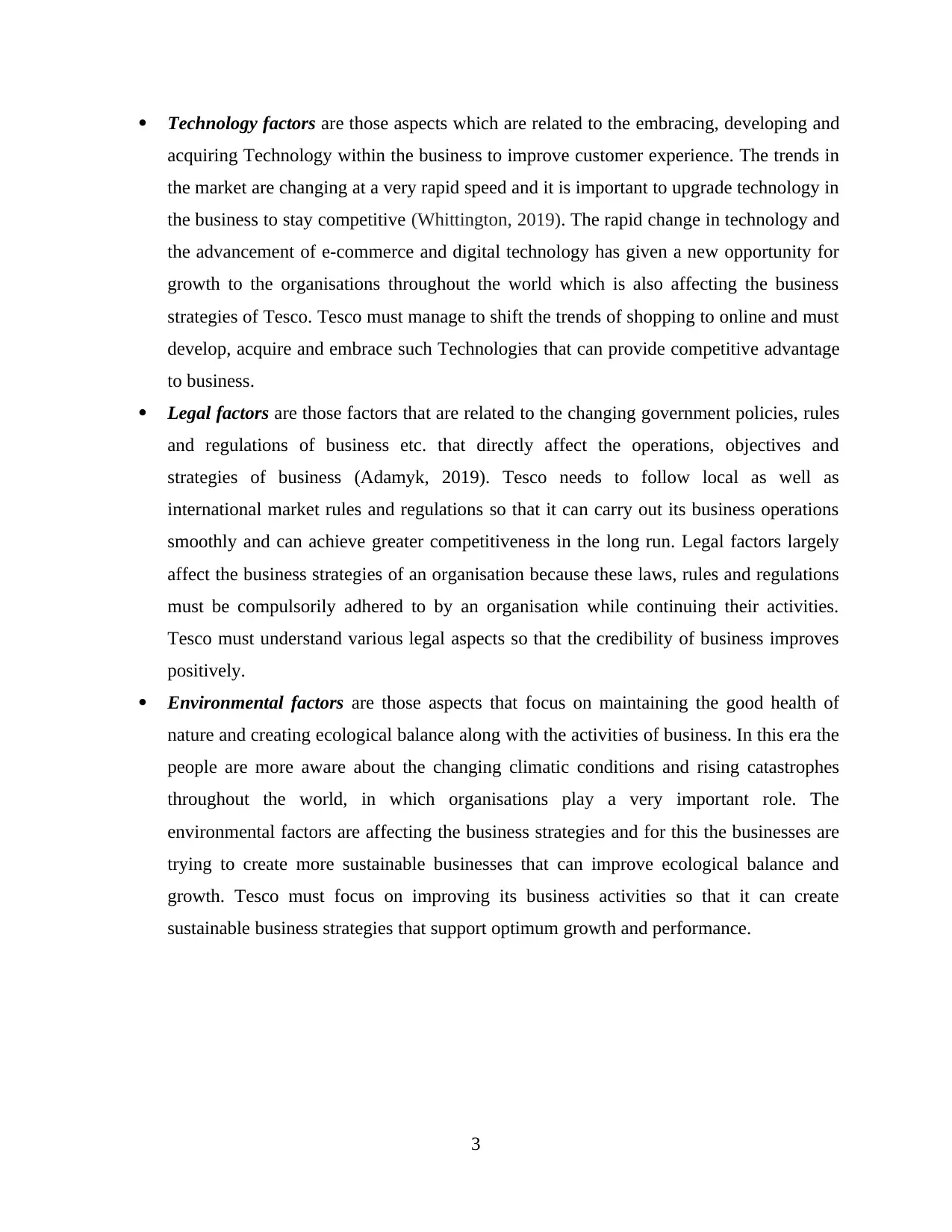
Technology factors are those aspects which are related to the embracing, developing and
acquiring Technology within the business to improve customer experience. The trends in
the market are changing at a very rapid speed and it is important to upgrade technology in
the business to stay competitive (Whittington, 2019). The rapid change in technology and
the advancement of e-commerce and digital technology has given a new opportunity for
growth to the organisations throughout the world which is also affecting the business
strategies of Tesco. Tesco must manage to shift the trends of shopping to online and must
develop, acquire and embrace such Technologies that can provide competitive advantage
to business.
Legal factors are those factors that are related to the changing government policies, rules
and regulations of business etc. that directly affect the operations, objectives and
strategies of business (Adamyk, 2019). Tesco needs to follow local as well as
international market rules and regulations so that it can carry out its business operations
smoothly and can achieve greater competitiveness in the long run. Legal factors largely
affect the business strategies of an organisation because these laws, rules and regulations
must be compulsorily adhered to by an organisation while continuing their activities.
Tesco must understand various legal aspects so that the credibility of business improves
positively.
Environmental factors are those aspects that focus on maintaining the good health of
nature and creating ecological balance along with the activities of business. In this era the
people are more aware about the changing climatic conditions and rising catastrophes
throughout the world, in which organisations play a very important role. The
environmental factors are affecting the business strategies and for this the businesses are
trying to create more sustainable businesses that can improve ecological balance and
growth. Tesco must focus on improving its business activities so that it can create
sustainable business strategies that support optimum growth and performance.
3
acquiring Technology within the business to improve customer experience. The trends in
the market are changing at a very rapid speed and it is important to upgrade technology in
the business to stay competitive (Whittington, 2019). The rapid change in technology and
the advancement of e-commerce and digital technology has given a new opportunity for
growth to the organisations throughout the world which is also affecting the business
strategies of Tesco. Tesco must manage to shift the trends of shopping to online and must
develop, acquire and embrace such Technologies that can provide competitive advantage
to business.
Legal factors are those factors that are related to the changing government policies, rules
and regulations of business etc. that directly affect the operations, objectives and
strategies of business (Adamyk, 2019). Tesco needs to follow local as well as
international market rules and regulations so that it can carry out its business operations
smoothly and can achieve greater competitiveness in the long run. Legal factors largely
affect the business strategies of an organisation because these laws, rules and regulations
must be compulsorily adhered to by an organisation while continuing their activities.
Tesco must understand various legal aspects so that the credibility of business improves
positively.
Environmental factors are those aspects that focus on maintaining the good health of
nature and creating ecological balance along with the activities of business. In this era the
people are more aware about the changing climatic conditions and rising catastrophes
throughout the world, in which organisations play a very important role. The
environmental factors are affecting the business strategies and for this the businesses are
trying to create more sustainable businesses that can improve ecological balance and
growth. Tesco must focus on improving its business activities so that it can create
sustainable business strategies that support optimum growth and performance.
3
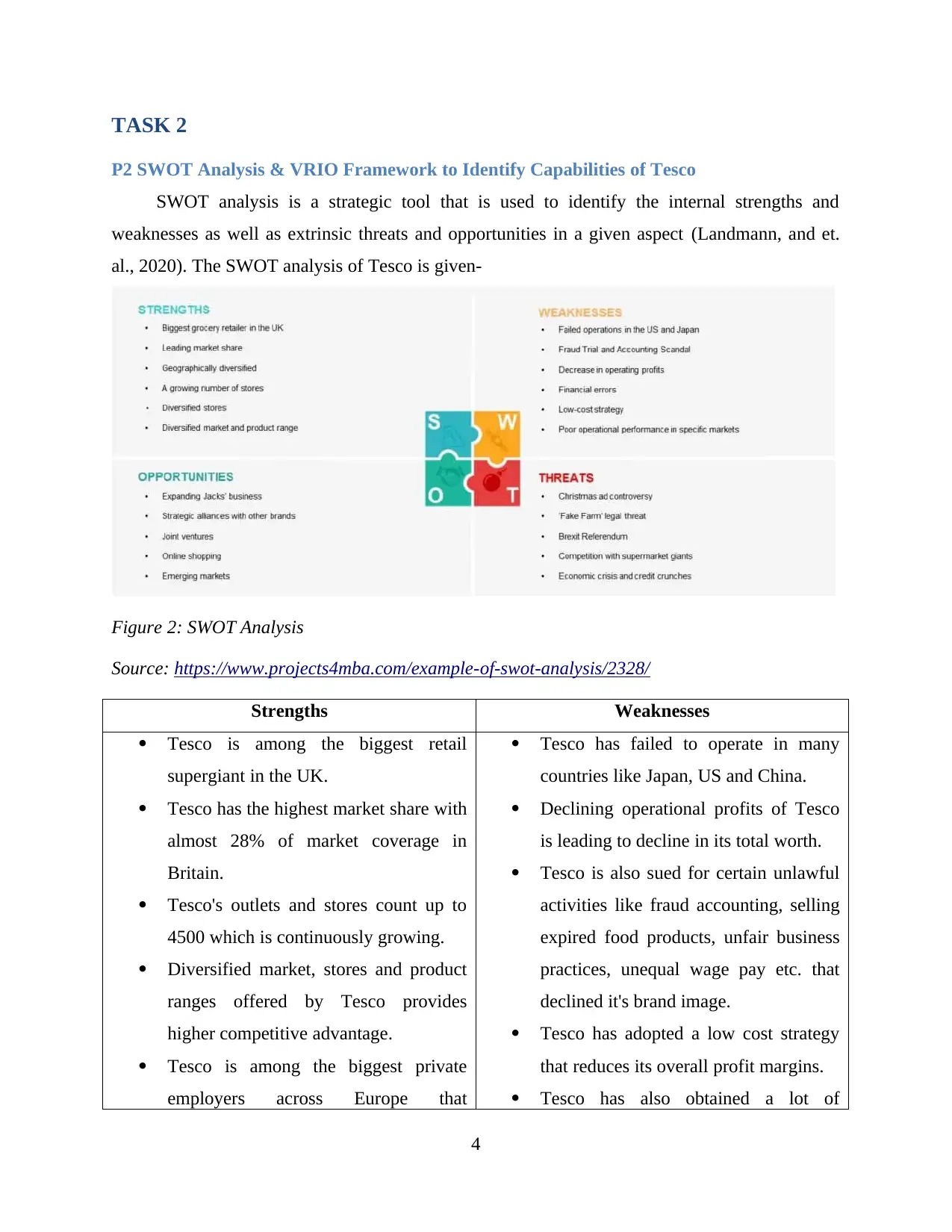
TASK 2
P2 SWOT Analysis & VRIO Framework to Identify Capabilities of Tesco
SWOT analysis is a strategic tool that is used to identify the internal strengths and
weaknesses as well as extrinsic threats and opportunities in a given aspect (Landmann, and et.
al., 2020). The SWOT analysis of Tesco is given-
Figure 2: SWOT Analysis
Source: https://www.projects4mba.com/example-of-swot-analysis/2328/
Strengths Weaknesses
Tesco is among the biggest retail
supergiant in the UK.
Tesco has the highest market share with
almost 28% of market coverage in
Britain.
Tesco's outlets and stores count up to
4500 which is continuously growing.
Diversified market, stores and product
ranges offered by Tesco provides
higher competitive advantage.
Tesco is among the biggest private
employers across Europe that
Tesco has failed to operate in many
countries like Japan, US and China.
Declining operational profits of Tesco
is leading to decline in its total worth.
Tesco is also sued for certain unlawful
activities like fraud accounting, selling
expired food products, unfair business
practices, unequal wage pay etc. that
declined it's brand image.
Tesco has adopted a low cost strategy
that reduces its overall profit margins.
Tesco has also obtained a lot of
4
P2 SWOT Analysis & VRIO Framework to Identify Capabilities of Tesco
SWOT analysis is a strategic tool that is used to identify the internal strengths and
weaknesses as well as extrinsic threats and opportunities in a given aspect (Landmann, and et.
al., 2020). The SWOT analysis of Tesco is given-
Figure 2: SWOT Analysis
Source: https://www.projects4mba.com/example-of-swot-analysis/2328/
Strengths Weaknesses
Tesco is among the biggest retail
supergiant in the UK.
Tesco has the highest market share with
almost 28% of market coverage in
Britain.
Tesco's outlets and stores count up to
4500 which is continuously growing.
Diversified market, stores and product
ranges offered by Tesco provides
higher competitive advantage.
Tesco is among the biggest private
employers across Europe that
Tesco has failed to operate in many
countries like Japan, US and China.
Declining operational profits of Tesco
is leading to decline in its total worth.
Tesco is also sued for certain unlawful
activities like fraud accounting, selling
expired food products, unfair business
practices, unequal wage pay etc. that
declined it's brand image.
Tesco has adopted a low cost strategy
that reduces its overall profit margins.
Tesco has also obtained a lot of
4
⊘ This is a preview!⊘
Do you want full access?
Subscribe today to unlock all pages.

Trusted by 1+ million students worldwide
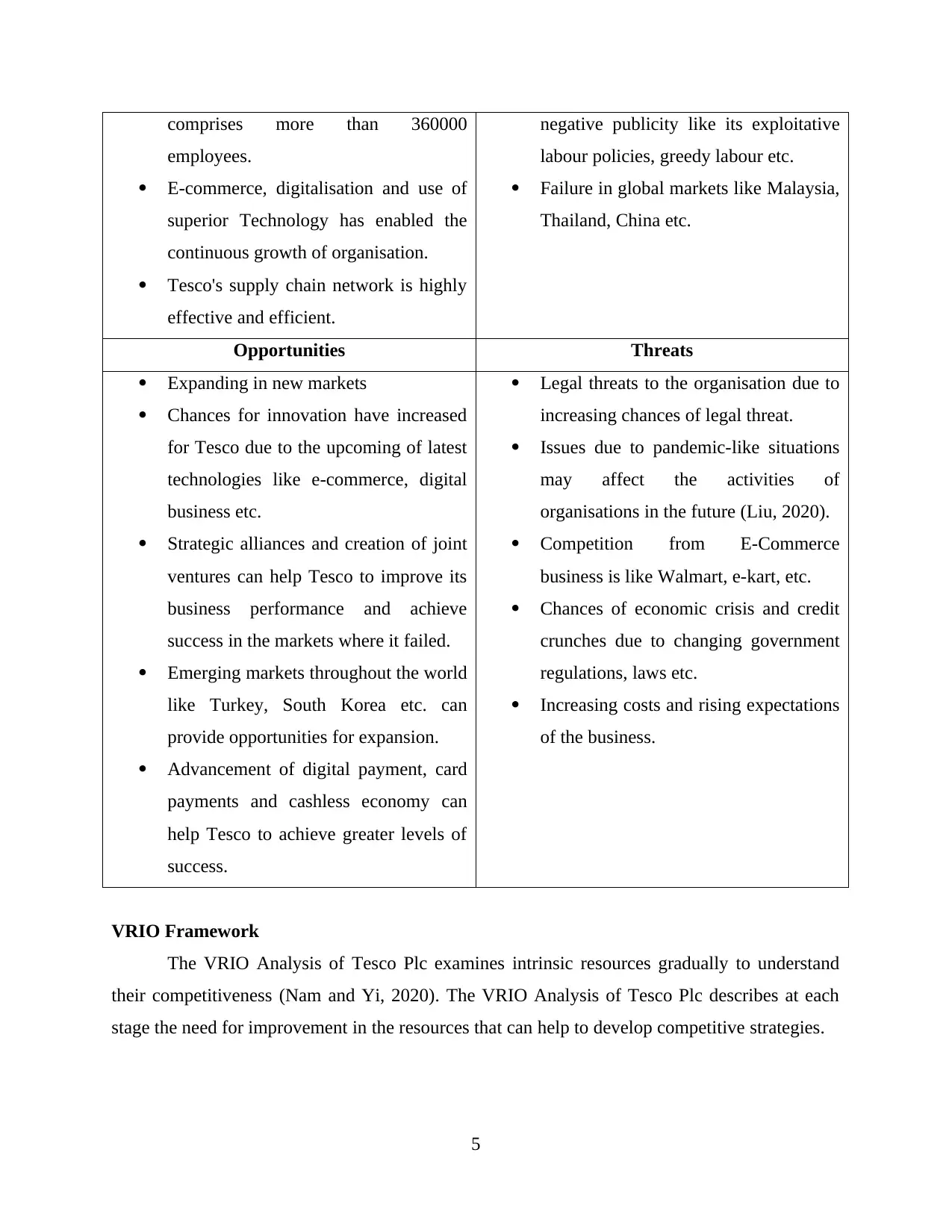
comprises more than 360000
employees.
E-commerce, digitalisation and use of
superior Technology has enabled the
continuous growth of organisation.
Tesco's supply chain network is highly
effective and efficient.
negative publicity like its exploitative
labour policies, greedy labour etc.
Failure in global markets like Malaysia,
Thailand, China etc.
Opportunities Threats
Expanding in new markets
Chances for innovation have increased
for Tesco due to the upcoming of latest
technologies like e-commerce, digital
business etc.
Strategic alliances and creation of joint
ventures can help Tesco to improve its
business performance and achieve
success in the markets where it failed.
Emerging markets throughout the world
like Turkey, South Korea etc. can
provide opportunities for expansion.
Advancement of digital payment, card
payments and cashless economy can
help Tesco to achieve greater levels of
success.
Legal threats to the organisation due to
increasing chances of legal threat.
Issues due to pandemic-like situations
may affect the activities of
organisations in the future (Liu, 2020).
Competition from E-Commerce
business is like Walmart, e-kart, etc.
Chances of economic crisis and credit
crunches due to changing government
regulations, laws etc.
Increasing costs and rising expectations
of the business.
VRIO Framework
The VRIO Analysis of Tesco Plc examines intrinsic resources gradually to understand
their competitiveness (Nam and Yi, 2020). The VRIO Analysis of Tesco Plc describes at each
stage the need for improvement in the resources that can help to develop competitive strategies.
5
employees.
E-commerce, digitalisation and use of
superior Technology has enabled the
continuous growth of organisation.
Tesco's supply chain network is highly
effective and efficient.
negative publicity like its exploitative
labour policies, greedy labour etc.
Failure in global markets like Malaysia,
Thailand, China etc.
Opportunities Threats
Expanding in new markets
Chances for innovation have increased
for Tesco due to the upcoming of latest
technologies like e-commerce, digital
business etc.
Strategic alliances and creation of joint
ventures can help Tesco to improve its
business performance and achieve
success in the markets where it failed.
Emerging markets throughout the world
like Turkey, South Korea etc. can
provide opportunities for expansion.
Advancement of digital payment, card
payments and cashless economy can
help Tesco to achieve greater levels of
success.
Legal threats to the organisation due to
increasing chances of legal threat.
Issues due to pandemic-like situations
may affect the activities of
organisations in the future (Liu, 2020).
Competition from E-Commerce
business is like Walmart, e-kart, etc.
Chances of economic crisis and credit
crunches due to changing government
regulations, laws etc.
Increasing costs and rising expectations
of the business.
VRIO Framework
The VRIO Analysis of Tesco Plc examines intrinsic resources gradually to understand
their competitiveness (Nam and Yi, 2020). The VRIO Analysis of Tesco Plc describes at each
stage the need for improvement in the resources that can help to develop competitive strategies.
5
Paraphrase This Document
Need a fresh take? Get an instant paraphrase of this document with our AI Paraphraser
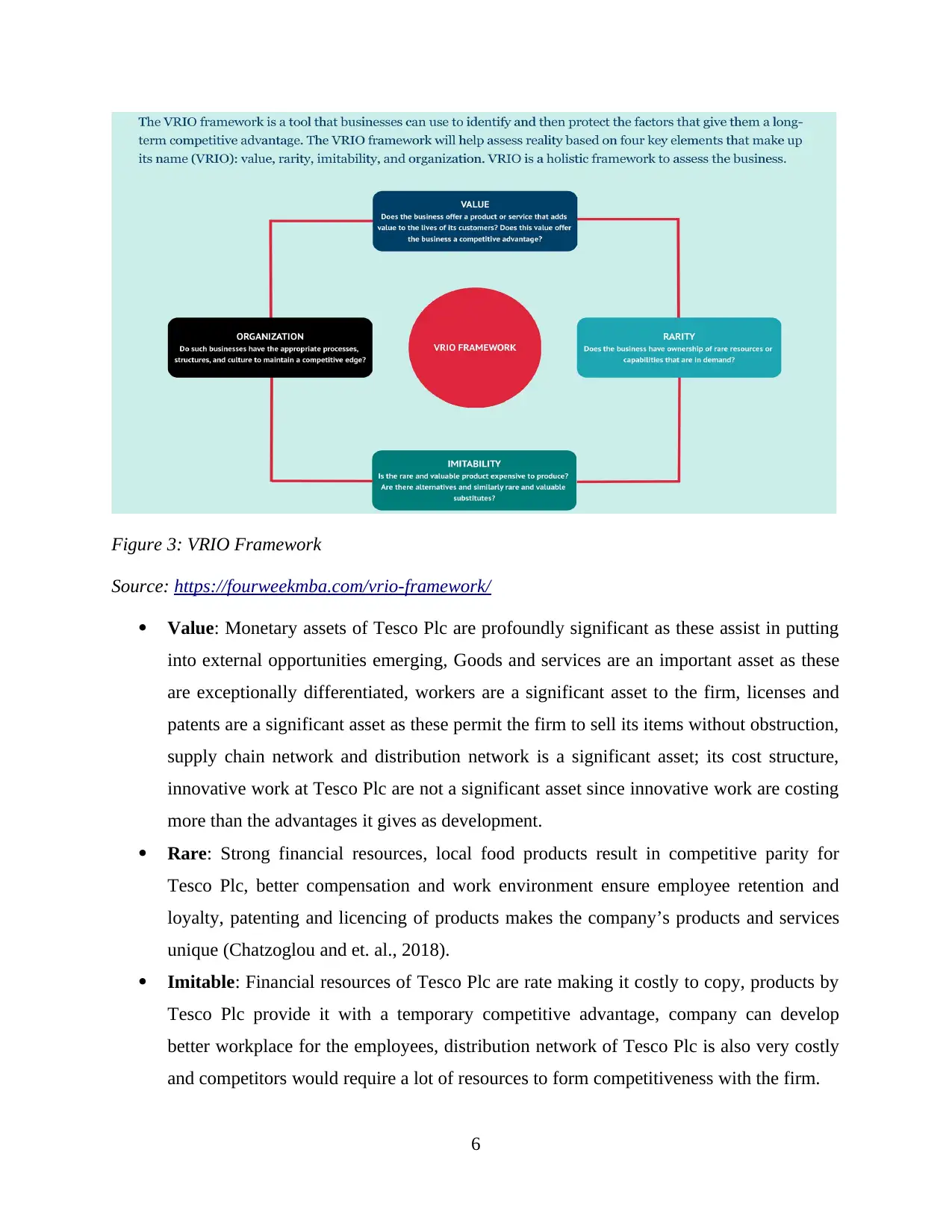
Figure 3: VRIO Framework
Source: https://fourweekmba.com/vrio-framework/
Value: Monetary assets of Tesco Plc are profoundly significant as these assist in putting
into external opportunities emerging, Goods and services are an important asset as these
are exceptionally differentiated, workers are a significant asset to the firm, licenses and
patents are a significant asset as these permit the firm to sell its items without obstruction,
supply chain network and distribution network is a significant asset; its cost structure,
innovative work at Tesco Plc are not a significant asset since innovative work are costing
more than the advantages it gives as development.
Rare: Strong financial resources, local food products result in competitive parity for
Tesco Plc, better compensation and work environment ensure employee retention and
loyalty, patenting and licencing of products makes the company’s products and services
unique (Chatzoglou and et. al., 2018).
Imitable: Financial resources of Tesco Plc are rate making it costly to copy, products by
Tesco Plc provide it with a temporary competitive advantage, company can develop
better workplace for the employees, distribution network of Tesco Plc is also very costly
and competitors would require a lot of resources to form competitiveness with the firm.
6
Source: https://fourweekmba.com/vrio-framework/
Value: Monetary assets of Tesco Plc are profoundly significant as these assist in putting
into external opportunities emerging, Goods and services are an important asset as these
are exceptionally differentiated, workers are a significant asset to the firm, licenses and
patents are a significant asset as these permit the firm to sell its items without obstruction,
supply chain network and distribution network is a significant asset; its cost structure,
innovative work at Tesco Plc are not a significant asset since innovative work are costing
more than the advantages it gives as development.
Rare: Strong financial resources, local food products result in competitive parity for
Tesco Plc, better compensation and work environment ensure employee retention and
loyalty, patenting and licencing of products makes the company’s products and services
unique (Chatzoglou and et. al., 2018).
Imitable: Financial resources of Tesco Plc are rate making it costly to copy, products by
Tesco Plc provide it with a temporary competitive advantage, company can develop
better workplace for the employees, distribution network of Tesco Plc is also very costly
and competitors would require a lot of resources to form competitiveness with the firm.
6

Organisation: Financial resources of Tesco are made in organised form to capture higher
value, the patents and trademarks of Tesco are not organised because the organisation
does not uses them to full potential, and supply chain and distribution channels of Tesco
are well organised to provide maximum profits.
The SWOT analysis and VRIO framework of Tesco explains that the organisation is highly
competitive and it have abilities to stand in the market. There are many opportunities in the
market of which advantages can be taken by Tesco and certain threats that must be eliminated by
the organisation. It is obtained from the SWOT analysis that Tesco have much strength as
compared to some weaknesses that organisation can overcome with certain efforts. With the help
of VRIO framework it is identified that Tesco’s products and services are highly precious for
their customers.
TASK 3
P3 Porter’s Five Forces to Evaluate Competitive Forces and Strategies to Improve
Competitiveness and Market Positioning
Porter's 5 forces of Tesco provides an examination of the impacts of 5 forces that are threat
of new entrants, competitive rivalry, threat of substitution buyer power and supplier power
(Singh, 2019), that affects comparative position of Tesco in the UK market.
7
value, the patents and trademarks of Tesco are not organised because the organisation
does not uses them to full potential, and supply chain and distribution channels of Tesco
are well organised to provide maximum profits.
The SWOT analysis and VRIO framework of Tesco explains that the organisation is highly
competitive and it have abilities to stand in the market. There are many opportunities in the
market of which advantages can be taken by Tesco and certain threats that must be eliminated by
the organisation. It is obtained from the SWOT analysis that Tesco have much strength as
compared to some weaknesses that organisation can overcome with certain efforts. With the help
of VRIO framework it is identified that Tesco’s products and services are highly precious for
their customers.
TASK 3
P3 Porter’s Five Forces to Evaluate Competitive Forces and Strategies to Improve
Competitiveness and Market Positioning
Porter's 5 forces of Tesco provides an examination of the impacts of 5 forces that are threat
of new entrants, competitive rivalry, threat of substitution buyer power and supplier power
(Singh, 2019), that affects comparative position of Tesco in the UK market.
7
⊘ This is a preview!⊘
Do you want full access?
Subscribe today to unlock all pages.

Trusted by 1+ million students worldwide
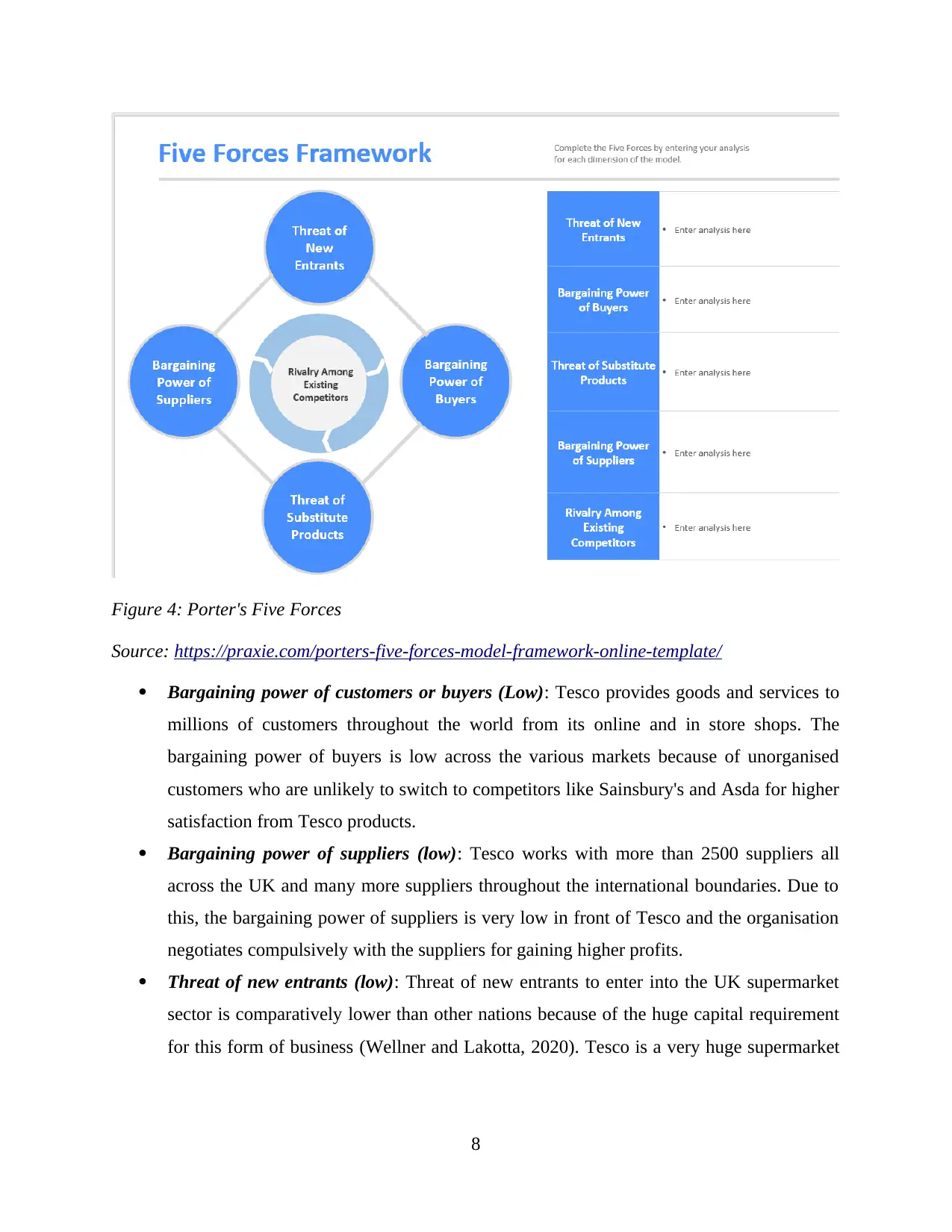
Figure 4: Porter's Five Forces
Source: https://praxie.com/porters-five-forces-model-framework-online-template/
Bargaining power of customers or buyers (Low): Tesco provides goods and services to
millions of customers throughout the world from its online and in store shops. The
bargaining power of buyers is low across the various markets because of unorganised
customers who are unlikely to switch to competitors like Sainsbury's and Asda for higher
satisfaction from Tesco products.
Bargaining power of suppliers (low): Tesco works with more than 2500 suppliers all
across the UK and many more suppliers throughout the international boundaries. Due to
this, the bargaining power of suppliers is very low in front of Tesco and the organisation
negotiates compulsively with the suppliers for gaining higher profits.
Threat of new entrants (low): Threat of new entrants to enter into the UK supermarket
sector is comparatively lower than other nations because of the huge capital requirement
for this form of business (Wellner and Lakotta, 2020). Tesco is a very huge supermarket
8
Source: https://praxie.com/porters-five-forces-model-framework-online-template/
Bargaining power of customers or buyers (Low): Tesco provides goods and services to
millions of customers throughout the world from its online and in store shops. The
bargaining power of buyers is low across the various markets because of unorganised
customers who are unlikely to switch to competitors like Sainsbury's and Asda for higher
satisfaction from Tesco products.
Bargaining power of suppliers (low): Tesco works with more than 2500 suppliers all
across the UK and many more suppliers throughout the international boundaries. Due to
this, the bargaining power of suppliers is very low in front of Tesco and the organisation
negotiates compulsively with the suppliers for gaining higher profits.
Threat of new entrants (low): Threat of new entrants to enter into the UK supermarket
sector is comparatively lower than other nations because of the huge capital requirement
for this form of business (Wellner and Lakotta, 2020). Tesco is a very huge supermarket
8
Paraphrase This Document
Need a fresh take? Get an instant paraphrase of this document with our AI Paraphraser
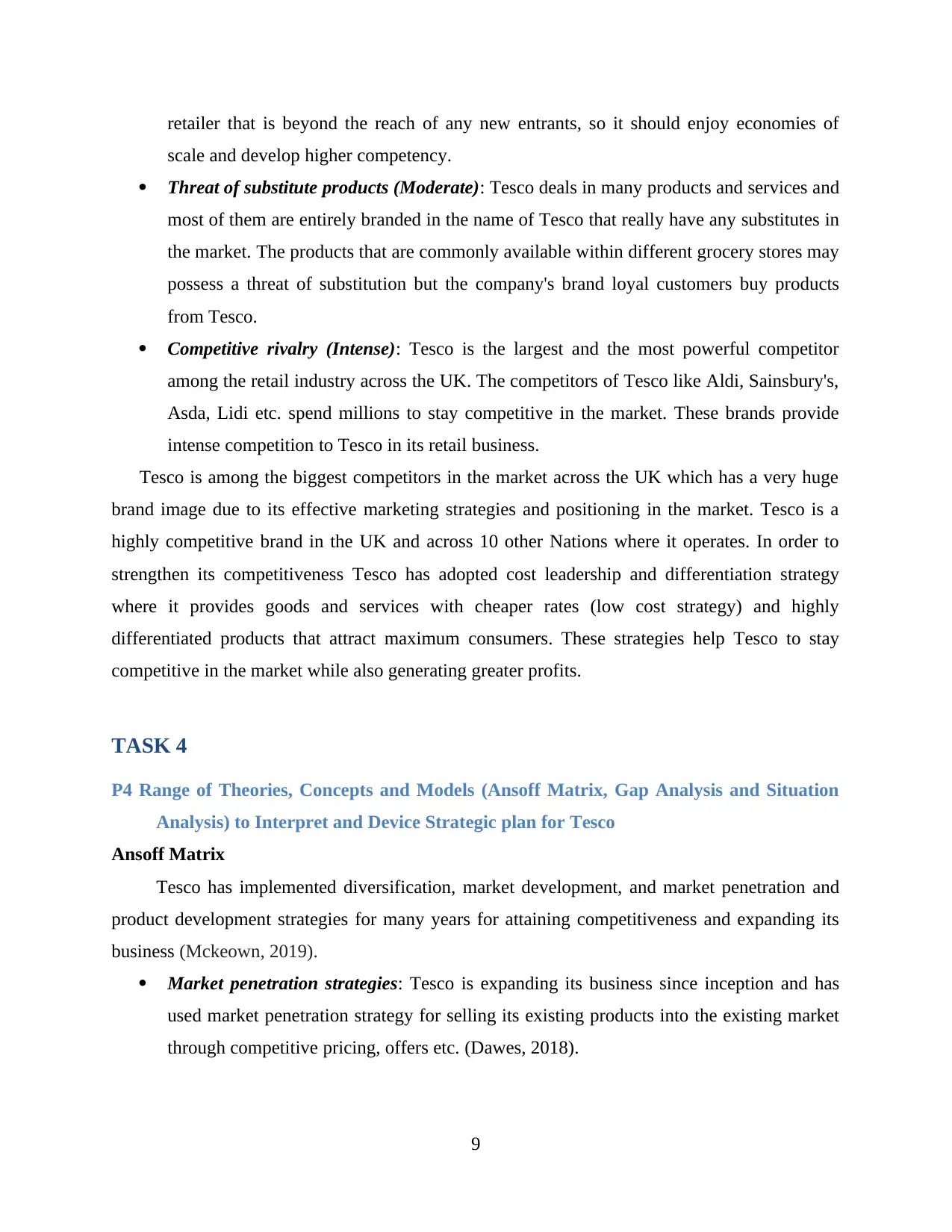
retailer that is beyond the reach of any new entrants, so it should enjoy economies of
scale and develop higher competency.
Threat of substitute products (Moderate): Tesco deals in many products and services and
most of them are entirely branded in the name of Tesco that really have any substitutes in
the market. The products that are commonly available within different grocery stores may
possess a threat of substitution but the company's brand loyal customers buy products
from Tesco.
Competitive rivalry (Intense): Tesco is the largest and the most powerful competitor
among the retail industry across the UK. The competitors of Tesco like Aldi, Sainsbury's,
Asda, Lidi etc. spend millions to stay competitive in the market. These brands provide
intense competition to Tesco in its retail business.
Tesco is among the biggest competitors in the market across the UK which has a very huge
brand image due to its effective marketing strategies and positioning in the market. Tesco is a
highly competitive brand in the UK and across 10 other Nations where it operates. In order to
strengthen its competitiveness Tesco has adopted cost leadership and differentiation strategy
where it provides goods and services with cheaper rates (low cost strategy) and highly
differentiated products that attract maximum consumers. These strategies help Tesco to stay
competitive in the market while also generating greater profits.
TASK 4
P4 Range of Theories, Concepts and Models (Ansoff Matrix, Gap Analysis and Situation
Analysis) to Interpret and Device Strategic plan for Tesco
Ansoff Matrix
Tesco has implemented diversification, market development, and market penetration and
product development strategies for many years for attaining competitiveness and expanding its
business (Mckeown, 2019).
Market penetration strategies: Tesco is expanding its business since inception and has
used market penetration strategy for selling its existing products into the existing market
through competitive pricing, offers etc. (Dawes, 2018).
9
scale and develop higher competency.
Threat of substitute products (Moderate): Tesco deals in many products and services and
most of them are entirely branded in the name of Tesco that really have any substitutes in
the market. The products that are commonly available within different grocery stores may
possess a threat of substitution but the company's brand loyal customers buy products
from Tesco.
Competitive rivalry (Intense): Tesco is the largest and the most powerful competitor
among the retail industry across the UK. The competitors of Tesco like Aldi, Sainsbury's,
Asda, Lidi etc. spend millions to stay competitive in the market. These brands provide
intense competition to Tesco in its retail business.
Tesco is among the biggest competitors in the market across the UK which has a very huge
brand image due to its effective marketing strategies and positioning in the market. Tesco is a
highly competitive brand in the UK and across 10 other Nations where it operates. In order to
strengthen its competitiveness Tesco has adopted cost leadership and differentiation strategy
where it provides goods and services with cheaper rates (low cost strategy) and highly
differentiated products that attract maximum consumers. These strategies help Tesco to stay
competitive in the market while also generating greater profits.
TASK 4
P4 Range of Theories, Concepts and Models (Ansoff Matrix, Gap Analysis and Situation
Analysis) to Interpret and Device Strategic plan for Tesco
Ansoff Matrix
Tesco has implemented diversification, market development, and market penetration and
product development strategies for many years for attaining competitiveness and expanding its
business (Mckeown, 2019).
Market penetration strategies: Tesco is expanding its business since inception and has
used market penetration strategy for selling its existing products into the existing market
through competitive pricing, offers etc. (Dawes, 2018).
9
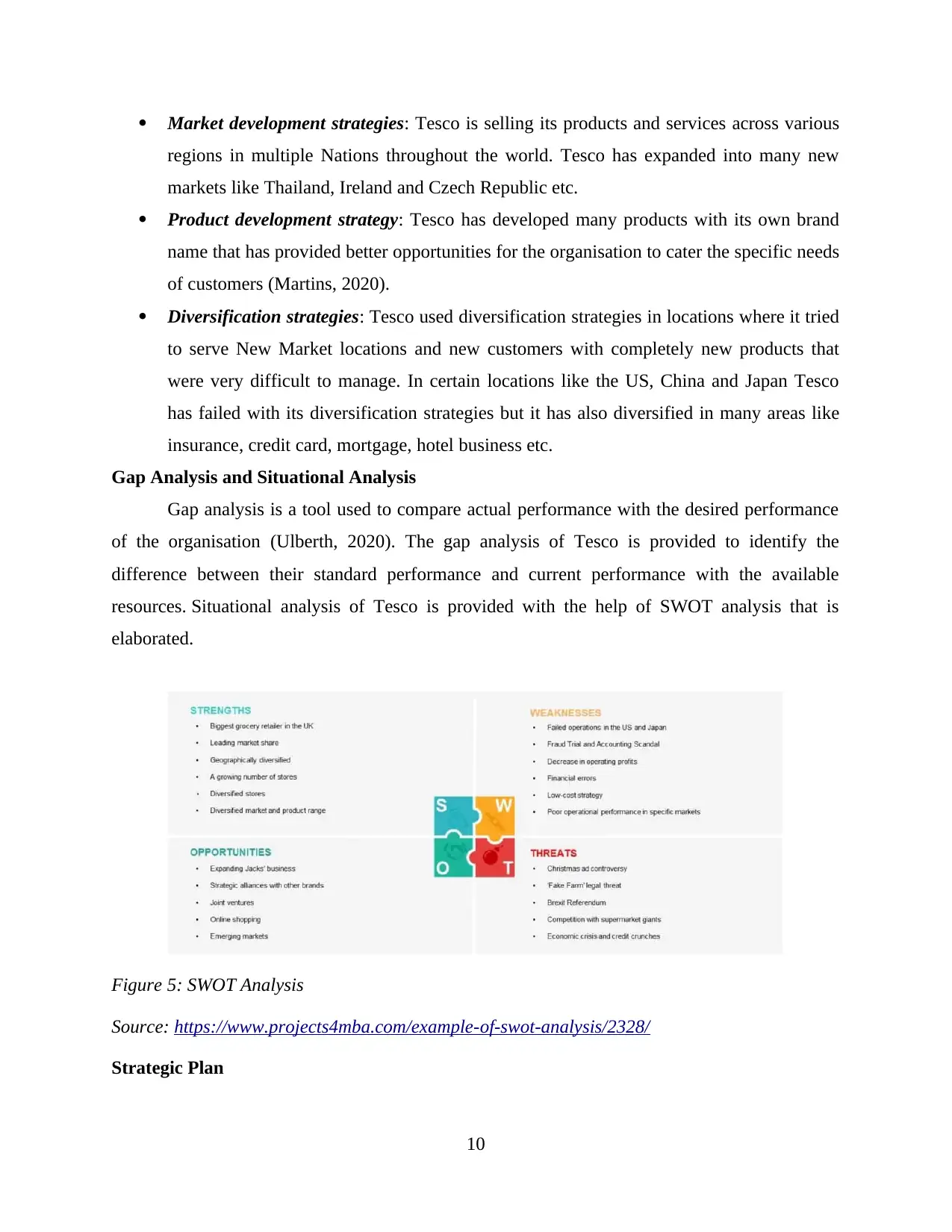
Market development strategies: Tesco is selling its products and services across various
regions in multiple Nations throughout the world. Tesco has expanded into many new
markets like Thailand, Ireland and Czech Republic etc.
Product development strategy: Tesco has developed many products with its own brand
name that has provided better opportunities for the organisation to cater the specific needs
of customers (Martins, 2020).
Diversification strategies: Tesco used diversification strategies in locations where it tried
to serve New Market locations and new customers with completely new products that
were very difficult to manage. In certain locations like the US, China and Japan Tesco
has failed with its diversification strategies but it has also diversified in many areas like
insurance, credit card, mortgage, hotel business etc.
Gap Analysis and Situational Analysis
Gap analysis is a tool used to compare actual performance with the desired performance
of the organisation (Ulberth, 2020). The gap analysis of Tesco is provided to identify the
difference between their standard performance and current performance with the available
resources. Situational analysis of Tesco is provided with the help of SWOT analysis that is
elaborated.
Figure 5: SWOT Analysis
Source: https://www.projects4mba.com/example-of-swot-analysis/2328/
Strategic Plan
10
regions in multiple Nations throughout the world. Tesco has expanded into many new
markets like Thailand, Ireland and Czech Republic etc.
Product development strategy: Tesco has developed many products with its own brand
name that has provided better opportunities for the organisation to cater the specific needs
of customers (Martins, 2020).
Diversification strategies: Tesco used diversification strategies in locations where it tried
to serve New Market locations and new customers with completely new products that
were very difficult to manage. In certain locations like the US, China and Japan Tesco
has failed with its diversification strategies but it has also diversified in many areas like
insurance, credit card, mortgage, hotel business etc.
Gap Analysis and Situational Analysis
Gap analysis is a tool used to compare actual performance with the desired performance
of the organisation (Ulberth, 2020). The gap analysis of Tesco is provided to identify the
difference between their standard performance and current performance with the available
resources. Situational analysis of Tesco is provided with the help of SWOT analysis that is
elaborated.
Figure 5: SWOT Analysis
Source: https://www.projects4mba.com/example-of-swot-analysis/2328/
Strategic Plan
10
⊘ This is a preview!⊘
Do you want full access?
Subscribe today to unlock all pages.

Trusted by 1+ million students worldwide
1 out of 15
Related Documents
Your All-in-One AI-Powered Toolkit for Academic Success.
+13062052269
info@desklib.com
Available 24*7 on WhatsApp / Email
![[object Object]](/_next/static/media/star-bottom.7253800d.svg)
Unlock your academic potential
Copyright © 2020–2025 A2Z Services. All Rights Reserved. Developed and managed by ZUCOL.



